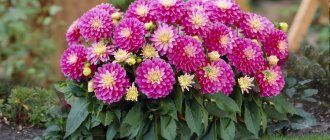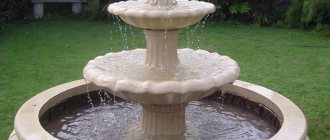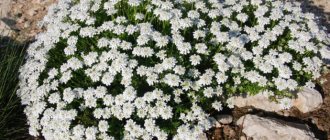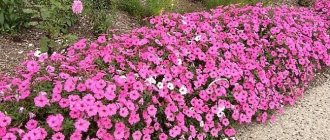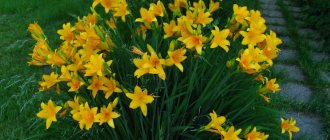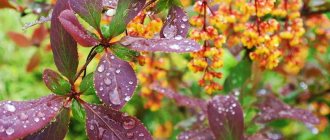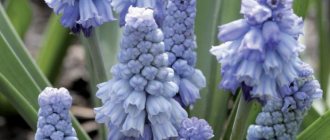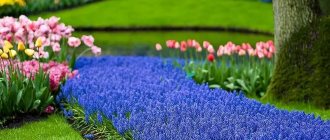Specifics of flower beds of white perennials
Each color has a magic that evokes specific emotions and states of mind. But only the white shade evokes a feeling of elegance, lightness and purity. If you use these flowers for a flower bed, the area will visually expand. According to landscape designers, it is better to grow such plants in a recreation area or near a pond.
Attention! There is often a misconception that there is nothing difficult in decorating a flower bed with flowers of the same shade. But in addition to the right design solution, you should also follow the recommendations for creating a flower garden that can bring this idea to life.
Before developing a flowerbed project, you need to consider that:
- White flowers for the garden will look advantageous against the background of a hedge or lawn. But at the same time, you should not plant near bright buildings or fences;
- perennials should be at least half of all crops in the flowerbed. Annuals will complement them well due to their early and longer growing season;
- a monochromatic flower garden should have three or four tiers. In the first one it is necessary to plant ornamental grasses, and in the last one - bushes, vines, trees;
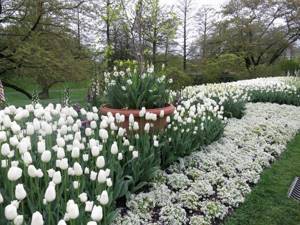
- when choosing white perennial flowers, you should take into account the soil on which planting and care are possible, and how often you need to water;
- the neighborhood should be with plants of different shapes. This approach will help avoid visual monotony;
- A maximum of three copies of one species are allowed.
In addition, it is important to take into account the budding period. One flower bed should have two types of flowers growing at the same time. It must be remembered that the desired result will be obtained not in 12 months, but in at least 2 seasons. But you will be able to fully admire the beauty of the flower garden after 3 years.
Lobularia marine
White varieties of lobularia are a real find. This is a ground cover plant that is used in rock gardens, ridges, and alpine slides. The bush grows very quickly, covering large areas. It reproduces easily by division.
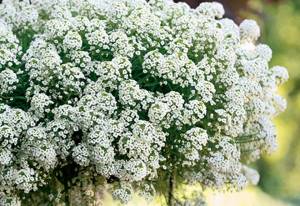
Lobularia is easy to care for and does not require scrupulous care. It is enough to water it during dry seasons. It attracts a large number of pollinators, but people can also smell the scent.
Related article:
Colchicum autumn flower
Secrets of white permanence for flower beds
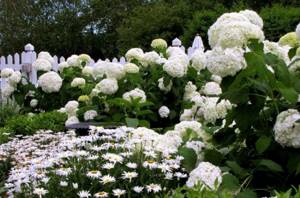
It is almost impossible to find pure white in the garden. The same rule applies to black shades. Garden plants are often perceived as white if they are close to this palette. We are talking about cream, pink, light blue, light green or lilac. But when compared with the original, the whole play of shades becomes clear. If we talk about the principle of the influence of white flowers, then they are the same.
Attention!
When creating a monochromatic flower garden in the country with an emphasis on white, you should take into account that this name is conditional. In fact, this means compositions of 2 different shades, because white is a complement to the brighter one.
Green leaves highlight the attractiveness of light colors and make them brighter. If you want the color scheme of the flowerbed to be exactly white, then you should take into account some aspects and nuances of greenery that can enhance this effect or, on the contrary, the feeling of predominance of whiteness will be spoiled. When designing light areas, designers recommend not avoiding coniferous or deciduous bushes.
To make a snow-white flower garden beautiful, you should take care of its appearance in autumn and spring. There are few white-blooming crops whose growing season occurs at the beginning and end of the dacha season. The flowerbed will be empty or ugly until the inflorescences open or after they fall, so you need to prepare plants with bright foliage in advance. In addition, all flowers must be in perfect condition. You also need to play with the shapes and sizes of crops. If the inflorescences are small, then they must be combined with large ones.
Ampelous petunias
If you want to bring coolness and freshness to a hot summer garden, then ampelous white petunias are the best way to do this. The main condition is that they should be located at a decent distance from the ground, since during rains, impacting drops can ricochet out dirt, which will smear the petals and ruin the appearance of the flower.
Related article:
Lychnis (Zorka) for your garden: types and description
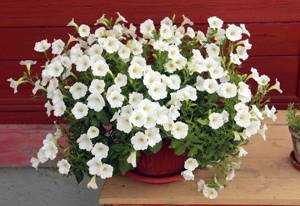
Along with white ampelous petunias, cascade varieties or surfinias can be considered, since the principles of caring for them are approximately the same, and they practically do not differ in the number of white inflorescences.
Pros and cons of perennials
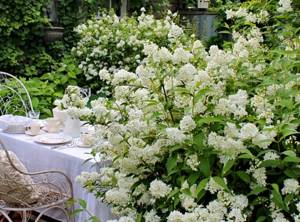
Owners of summer cottages make a choice in favor of perennial flowers, since they are unpretentious in care and growing conditions. Among the ornamental crops, you can choose varieties that will bloom in the spring-autumn period and will give the area a well-groomed look without constant weeding or watering.
In addition to decoration, garden flowers can also be useful. When they grow in the flowerbed, the weeds are forced out, and the fertile layer of soil is preserved.
There is an opinion that perennials are inferior in beauty to their annual “relatives”. But it is caused by the lack of necessary knowledge about the types of perennial shrubs. Among them there are many that intoxicate with their aroma and delight with their different shapes and sizes.
Attention!
When combining annuals and perennials, the latter should be located in the back row. It is worth starting with low-growing crops, and then planting medium-growing ones and finally tall-growing ones. This way they won't cover each other.
But, despite these advantages, growing perennial garden flowers also has disadvantages. So, they grow quickly, so they occupy an increasingly larger area of the flower garden. To avoid this, you will have to put up a fence.
Trees and shrubs in landscape design
The importance of white flowering trees cannot be underestimated. If you place cherries, apricots, and plums in the garden, you can get a simply stunning effect during their flowering period. These are plants that captivate the eye and delight the soul.
Lilac and spirea bushes, like a bride, are located in the garden. They are like nothing else. It is enough to add striped milkweed to the flowerbed and see how everything changes. The harmony of shades will fill the area with a unique atmosphere of peace and comfort.
White representatives of flora in landscape design are always fresh and original. They can be combined with each other. A thoughtful combination of plants of different types and colors will help achieve the desired result.
The best perennials with white flowers
Choosing perennial flowers for a flower bed will justify its expediency. Every year the site will need less and less attention, but the greenery will be rampant. In this case, the growing season of the crop can occur in spring, summer and autumn.
White perennials blooming in spring
Flowers that open in the first days of spring are called early bloomers. But there are also plants whose growing season occurs in April and May, when the sun has warmed the earth and air well.
Snowdrop
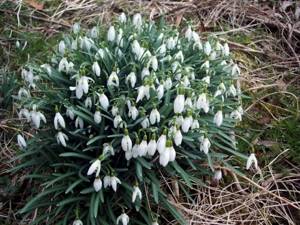
Galanthus is a bulbous crop that begins to grow as soon as the snow melts. The growing season is short - lasts approximately 30 days and occurs in March. Then the upper part dies off and the snowdrop is not visible until next year.
This flower loves areas well lit by the sun, but will also take root in the shade. Grows on any type of soil. Reproduction occurs by bulbs and seeds carried by ants. In the first case, planting should be done in the fall. And in the spring, after the end of the flowering period, the bushes need to be replanted.
White hellebore
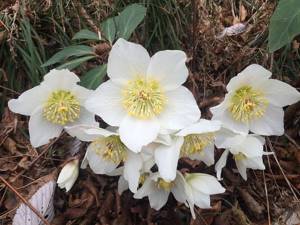
The plant is evergreen and drought resistant. The white flower does not require special soil; it prefers shade from large trees. The growing season occurs in early spring. Sometimes it can bloom even in January.
Interesting!
There is a legend about the origin of Helleborus. The poor shepherd decided to give a gift to the divine baby, but he couldn’t find anything worthwhile, so he cried. But his tears managed to melt the snow cover, and underneath it was a beautiful flower.
The drooping inflorescences resemble lanterns, the diameter of which is 80 mm. Look perfect against the backdrop of a snow-covered area. It can grow in one place for a decade. Interest in the culture is also increased by the fact that there are several varieties of it with different shapes and shades. It has medicinal properties. Some varieties are poisonous.
The height of the flower reaches 0.5 m. Looks ideal in group planting. Propagate correctly by division, but you should not replant often. Therefore, it is advisable to first prepare a place for helleborus, preferably in the shade of deciduous trees. The soil should be moist.
Lily of the valley
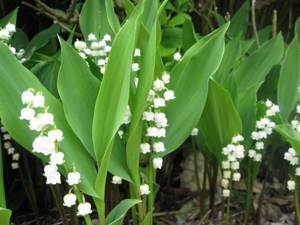
This culture will decorate a flower bed well in the shade or partial shade. The plant's beauty is distinguished by both its bell-shaped flowers with a pleasant aroma and its wide, dark green leaves. Tolerant to drought, but prefers moist soil and partial shade. But if you plant lily of the valley in strong shade, the number of flowers will decrease and the number of leaves will increase.
The soil should be slightly acidic, saturated with fertilizers. The flowering period begins in May and lasts 14 days. In some regions, growing season is possible in April. In a flower garden, the plant can be aggressive, because grows quickly and displaces other flowers. But before you decide to plant it, it is worth considering that all its parts are poisonous. Replant by division in spring or autumn.
Narcissus
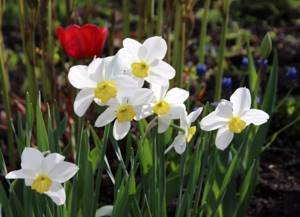
This culture is one of the popular ones. The white flower is picky about the type of soil in which it grows. The soil should be loose, nutritious, and constantly moist.
Attention!
Narcissus needs abundant watering, especially after the end of the growing season.
The plant takes root in open areas that are well lit by the sun. Plant it in groups of 1-2.5 dozen. The culture will “live” in one place for 3 to 5 years.
Goryanka
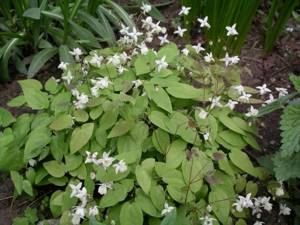
The flower will create a lush flower bed and decorate its foreground, where there is little lighting. The plant grows into bushes, but all the details can only be seen up close. The culture is small, grows up to 25 cm. The leaves are able to change their color from bronze to bright green.
Horny goat weed is undemanding to care. Can grow in full shade and in sunny areas. But partial shade is better. The only thing that is important to monitor is that there is no waterlogging.
Tulips
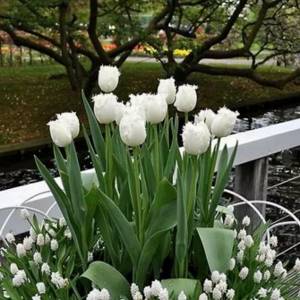
The flower has a wide variety of varieties, shapes, sizes, even shades. When plants begin to bloom, an association with spring and warmth involuntarily comes. In order for these crops to take root well and bloom wildly, it is necessary to provide them with favorable conditions.
We are talking about the right lighting and soil. If you want tulips to produce large buds every season, you need to dig them up every year and then replant them in a new place. In a flower garden, plants should be arranged in groups of 5-7 units.
Scilla and primrose
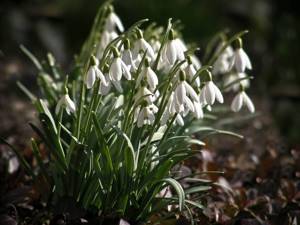
Scilla bloom in March: they decorate the garden at a time when many crops are just waking up from winter hibernation. They are resistant to sub-zero temperatures and are easy to care for. White perennial crops love loose soil rich in organic components. If there is stagnation of water or waterlogging of the soil, the blueberries will not take root. They will bloom in one place without transplanting for about 5 years.
Primrose is one of the representatives of primroses. It grows in shaded areas where direct sunlight does not reach. The soil should be loose, light, drained. In winter, the flower should be covered. Straw, dried leaves or spruce branches are suitable for this. The layer of covering material must be at least 7 cm.
White anemone
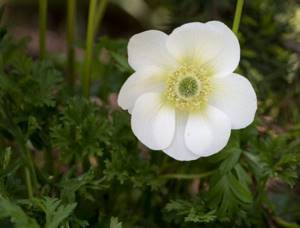
There are such varieties of these flowers: tuberous and rhizomatous. The latter are unpretentious in care, while the former are capricious. But there are still general requirements:
- organic feeding;
- water in hot weather;
- use of covering material for the winter.
Interesting!
This culture has several names, and there is a legend about its origin. According to it, the Lord had mercy and expelled the sinful ancestors from the ever-blooming garden. And he turned snowflakes into beautiful white flowers so that Eve would not be cold when she left the Garden of Eden.
White anemone is a delicate crop, although it is resistant to frost. Therefore, if you pick one flower, the entire bush will die. The plant will live in one place for 4-5 decades. He is not afraid of shade.
The flower is known for its medicinal properties. It's still in the mid-20th century. used to prepare tinctures and decoctions, so the anemone became a rare species. The white perennial will decorate the garden immediately after the snow melts, and will also become an emergency aid in the treatment of infectious diseases and colds. But at the same time, official medicine does not recognize this flower, and traditional methods can cause overdose and poisoning.
White perennials blooming in summer
It is also possible to paint a flower garden with light shades in the summer. There are many white perennials that will delight you with their pleasant smell and appearance. Therefore, choosing something is not difficult.
Peonies
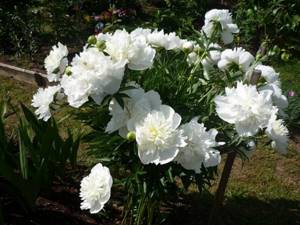
Plants with white inflorescences and a strong aroma are loved by many. They are light-loving, so it is better to plant bushes in an area that is illuminated by the sun all day. Peonies grow quickly; they need to be replanted no more than once every 7-10 years. In mid-autumn, flowers should be trimmed so that only sprouts 4-5 cm long remain to survive the winter.
Early varieties begin to bloom in the first month of summer. A bush can grow in one place for several decades if it is properly prepared. Peonies will die in conditions of stagnant liquid; they grow well in loam.
Attention!
If the soil in the garden is heavy, then when planting the crop in the hole, you need to add peat, sand, and compost.
Reproduction occurs by division. But often a renewal kidney is used for this procedure. For this purpose, in the spring it is cut off with part of the stem and root system. Then the bud is planted in the prepared soil so that it is on the surface.
Irises
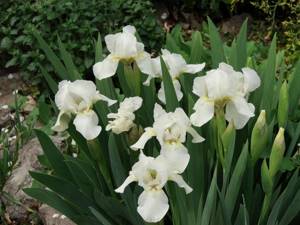
This culture is often found in gardens and summer cottages due to its simple care. It blooms especially luxuriantly in the third year after planting. Irises prefer light and are afraid of waterlogging. Replanting is required every 3-4 years, otherwise the irises may degenerate and will no longer bloom.
Breeders have developed many new varieties of these flowers. The white tint attracts dwarf and warty irises. Many of them smell so that this aroma cannot be forgotten. The growing season begins in May. Sometimes this date moves closer to summer.
Reproduction occurs by division. This should be done 14 days after flowering. The soil must be fertilized and neutral in acidity level.
Chrysanthemums
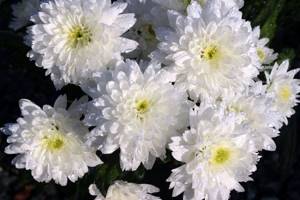
They delight with color until frost. They should be planted in a sunny place that is well protected from the wind. If the soil is weak, then it needs to be fertilized before planting chrysanthemums. In addition, it must contain sand and turf. Watering should be root. To make the flowers large, the buds must be pinched on the side shoots.
Attention!
Annual replanting will preserve the varietal characteristics of the crop.
White chrysanthemums come in different shapes and sizes. The growing season begins at the end of July and can last until the first frost. When grown in the same place for several years, the soil must be treated with copper sulfate to avoid fungus. A bouquet of these flowers can last up to 30 days in a vase. You can even transplant the plant into a pot. In this case, flowering will continue during the New Year holidays.
Volzhanka and delphinium
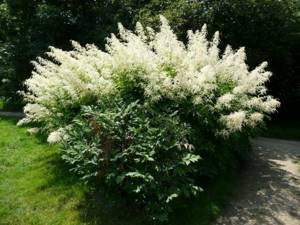
Volzhanka grows up to 2 m in height. This perennial is best planted in shady flower beds. The inflorescences are large, which are well combined with openwork feather-shaped leaves. The culture is an excellent honey plant and has a pleasant aroma. Without transplantation, it can “live” in one area for about two decades.
To grow a perennial like delphinium, you will have to put in a lot of effort. The flower prefers open areas of the garden, but protected from the wind. The plant is resistant to frost, but will die in conditions of stagnant water. The roots are superficial, so they can dry out. They grow in one place for a decade, so it is important to fertilize the hole well.
Water the delphinium sparingly and only in drought conditions. Peduncle shoots that grow strongly should be tied to trellises.
Nivyanyk
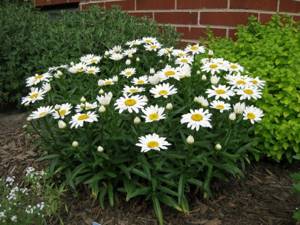
In appearance, this plant resembles a chamomile. The growing season occurs twice a season. Abundant flowering is possible in sunny places, well fertilized with black soil. Watering is necessary only during drought.
Attention!
Inflorescences should be removed immediately after wilting. Otherwise, they will reduce the decorative effect of the flower bed. As soon as the growing season is completed, cut the stems at a height of 10-15 cm.
Nielberry has strong roots. In addition, the flower loves light, is unpretentious in care and is frost-resistant. Prefers moderate humidity levels and garden soil. The growing season is June-August. It can be propagated by seed and by planting bushes. It grows in one place for up to 7 years, but replanting is required every 3 years.
White perennials blooming in autumn
Before the cold weather, you can also enjoy white flowers. Admiring such a flowerbed will lift your spirits, prolong summer emotions and give you vivid memories.
Bush aster
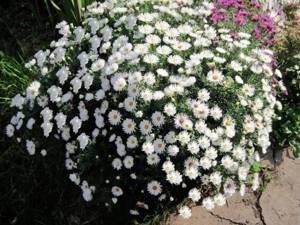
This flower is perennial and does not require special care. Reproduction occurs by dividing the bush. It is better to carry out the procedure in the spring. The varieties “Niobea” and “Alba flor captivity” have white flowers. The growing season of bush aster begins at the end of the summer season, at a time when other crops have already bloomed.
The plant is not afraid of frost, so it blooms even at the first frost. Prefers fertile soil and a well-lit area of the garden. The aster grows quickly, producing many side shoots.
Astilbe

The flower is suitable for flower beds located in the shade. It grows in areas with high levels of humidity, so the soil must be fertile, but moisture-intensive. Astilbe is decorative throughout the season thanks to its leaves, and not only during the growing season. As soon as the season is over, you need to cut the stems at soil level and mulch with peat.
The root system of the plant is strong and unpretentious in care. Reproduction occurs by dividing the rhizome or seed material. Flowering occurs between June and early August. It will look ideal near blue spruce or cypress, thuja, and fern.
Hydrangea
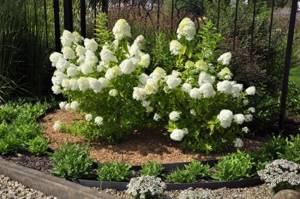
The shrub is distinguished by beautiful flowering and large flowers resembling a ball. Looks great when grown on its own, as well as when planted in a group. The shade of hydrangea is not terrible, but the humidity requirements are increased.
Watering should be done abundantly and on time. The liquid water should be soft and free of lime. Mulching, as recommended by gardeners, should be done with peat, sawdust or pine needles. In winter it is necessary to protect from frost.
Phlox
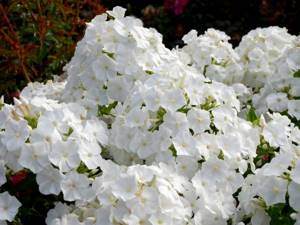
The culture is unpretentious in care and is characterized by lush vegetation and a pleasant aroma. It is better to plant in a sunny area or in partial shade in loose soil rich in nutritional components. This white perennial loves moisture, but its stagnation is detrimental to it. Before winter, the plant needs to be hilled up. Otherwise, the underground buds will freeze.
Bushes of lush flowers can be confused with snow. White phlox should be planted at the back or in the middle of the flower bed, since their height reaches 0.9-1.2 m. They bloom at the end of the first summer month and this period lasts until September. But it depends on the variety.
Cohosh
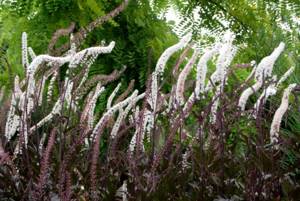
May be interesting Mirabilis - planting and care in open ground Features of growing and caring for anthurium at home Dahlias: when to dig and how to store at home
A flower belonging to the ranunculaceae family. The growing season falls in September-October. The stem of the crop is branched and tall - it can grow up to 2 m. The leaves are openwork, and small white inflorescences are collected in brushes.
Cohosh, or more precisely parts of its root system, are often used for medicinal purposes. But at the same time, the plant is poisonous. Therefore, working with it must be careful. Thus, it is important to wear gloves and wash your hands after handling the crop.
It can be difficult to make a flowerbed all in white, but it is possible. In advance, you only need to select the flowers that will grow on the site, and also read their description. This is important to ensure the plants receive proper care. If you follow these rules, your flower garden will delight you with beautiful plants and pleasant aromas.
Chrysanthemums
After a colorful summer season, autumn's white flowers look clean and fresh. Chrysanthemums are always a highlight in well-kept gardens, and white ones become a special accent. Varieties such as Polar Bear, White Poodle, Ribonet, Regina, Furor, Coconut or Khrustalnaya will fill autumn flower beds with snow-white petals for a whole month, and sometimes longer.
Related article:
Growing Dalia
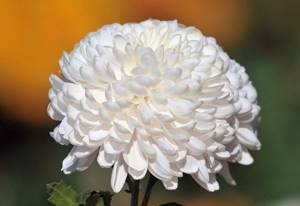
They look no less impressive in bouquets, making them elegant, which is why such chrysanthemums are also grown for cutting.
